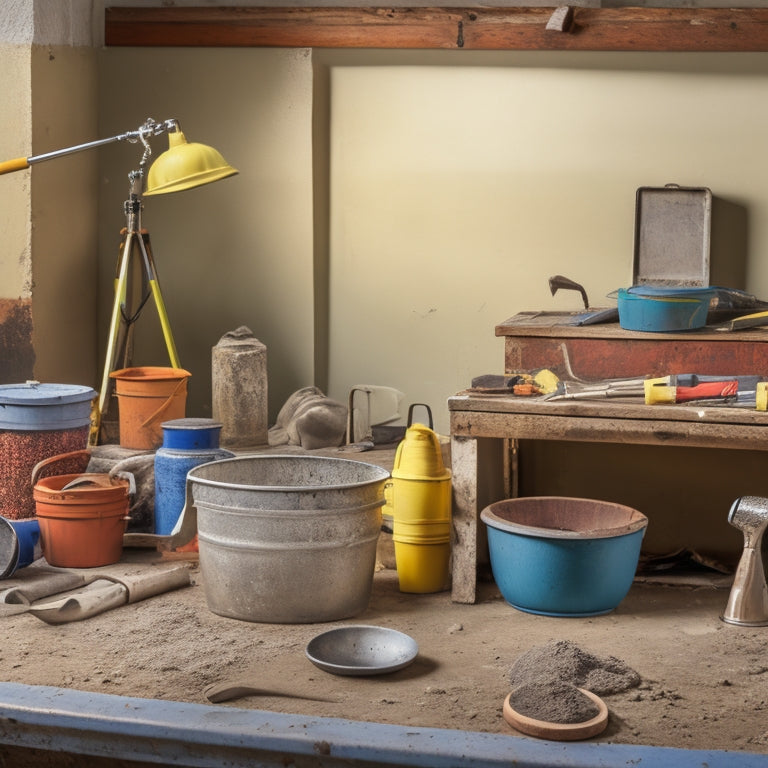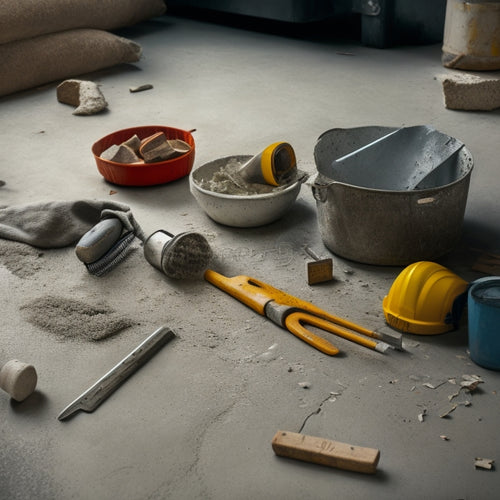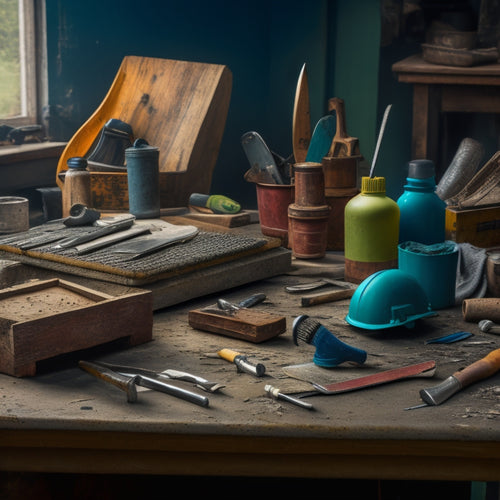
Top Tools for Tamping Concrete Mix for Walls
Share
When it comes to tamping concrete mix for walls, you'll want to choose tools that deliver durability, ergonomics, and customization. Hand tampers excel in precision and small project management, while power tampers shine in efficiency and large-scale tasks. Essential features to evaluate include blade strength, weight, and balance. Top hand tamper options include steel, fiberglass, and aluminum, each with its own strengths and weaknesses. For power tampers, electric, pneumatic, and gas-powered models offer varying benefits. By understanding your project needs and tool features, you'll be well on your way to achieving a smooth, even finish - and there's more to explore in the world of tamping tools.
Key Takeaways
• Choose between hand tampers for precision and small projects, and power tampers for efficiency and larger projects, based on project requirements.
• Select hand tampers with durable materials, ergonomic handles, and adjustable designs for comfort, precision, and control.
• Power tampers come in electric, pneumatic, and gas-powered models, each with unique features, benefits, and suitability for specific tasks.
• Consider factors like weight, balance, and maintenance when selecting a tamper, as they impact handling, force application, and tool longevity.
• Ensure proper safety precautions, including a hazard assessment, PPE, and ventilation, to minimize risks when working with concrete mix and tamping tools.
Essential Features to Consider
When selecting a tool for tamping concrete mix, you should prioritize those with durable, wear-resistant materials and ergonomic handles that reduce fatigue and improve control. This is vital for achieving ideal results, especially when working with varying concrete mix consistencies. A high-quality tamper will help you maintain a consistent tamping technique, which is essential for ensuring a strong and even finish.
Look for tools with sturdy, rust-resistant blades that can withstand the rigors of repeated use. An adjustable handle will also allow you to tailor the tool to your specific needs, providing greater comfort and precision.
Additionally, consider the weight and balance of the tamper, as these factors can greatly impact your ability to control the tool and maintain a consistent tamping technique. By choosing a tamper with these essential features, you'll be well on your way to achieving professional-grade results and mastering the art of tamping concrete mix.
Hand Tamper Vs Power Tamper
You'll need to decide between a hand tamper and a power tamper, each with its unique strengths and weaknesses, depending on the scope and requirements of your concrete mixing project.
Hand tampers offer advantages regarding precision and control, allowing you to manually compact the concrete mix in small, intricate areas. They're ideal for smaller projects or when working in tight spaces.
On the other hand, power tampers excel in efficiency, saving you time and energy when dealing with large quantities of concrete. They're perfect for bigger projects that require rapid compaction. However, they can be heavier and more difficult to maneuver, making them less suitable for smaller areas.
When choosing between the two, consider the size of your project and the level of precision required. If you're working on a large-scale project with minimal obstacles, a power tamper's efficiency will be invaluable.
But if you need to compact concrete in small, hard-to-reach areas, a hand tamper's advantages will shine. By selecting the right tool for the job, you'll guarantee a solid foundation for your walls and a successful concrete mixing project.
Top Hand Tamper Options
As you explore the world of hand tamping, you'll want to focus on three key aspects:
-
Mastering various tamping techniques to achieve ideal results.
-
Selecting a hand tamper with a design that suits your needs.
-
Choosing a tamper made from materials that can withstand the demands of the job.
By considering these factors, you'll be well on your way to selecting the perfect hand tamper for your concrete mixing projects.
In the following sections, we'll examine each of these points in detail to help you make an informed decision.
Tamping Techniques to Master
Mastering the proper tamping techniques with top hand tamper options is essential to achieving a smooth, even finish in your concrete project. As you work with concrete, you'll need to verify that it's compacted correctly to prevent air pockets and unevenness. This is where tamping techniques come into play.
To achieve the best concrete compaction, follow these essential tamping techniques:
-
Start with a gentle touch: Begin by applying gentle pressure to the tamper, gradually increasing the force as needed. This helps to prevent over-compaction, which can lead to a rough finish.
-
Use a rhythmic motion: Move the tamper in a consistent, rhythmic pattern to verify even compaction. This helps to distribute the force evenly and prevent air pockets from forming.
-
Work in small sections: Divide your concrete area into smaller sections, tamping each one thoroughly before moving on to the next. This helps to maintain control and prevent over-compaction.
Hand Tamper Design Options
With a solid grasp of tamping techniques, it's time to select the right hand tamper to get the job done efficiently, and that's where design options come into play.
As you choose a hand tamper, consider the ergonomics of the tool. Look for a tamper with a contoured handle that fits comfortably in your hand, reducing fatigue and strain. A well-designed handle will also provide a secure grip, even with gloved hands. Additionally, think about the weight and balance of the tamper. A tamper that's too heavy can be cumbersome, while one that's too light may not provide enough force.
When it comes to hand tamper maintenance, consider a design with easy-to-clean surfaces and minimal crevices where concrete can accumulate. A tamper with removable parts or a rust-resistant coating can also simplify maintenance.
Best Tamper Materials Used
Selecting the right material for your hand tamper is essential, as it directly impacts the tool's durability, weight, and overall performance. You want a tamper that can withstand the rigors of repeated use and harsh job site conditions.
When evaluating tamper material types, take into account the following key factors:
-
Steel: Offers exceptional strength, durability, and resistance to corrosion. Steel tamps are ideal for heavy-duty applications and can handle high-impact tamping.
-
Fiberglass: Provides a lightweight, yet robust option that reduces fatigue and improves ergonomics. Fiberglass tamps are suitable for medium-to-heavy-duty use and offer good resistance to corrosion.
-
Aluminum: Strikes a balance between strength, weight, and cost. Aluminum tamps are ideal for light-to-medium-duty applications and are often preferred for their ease of handling.
When choosing a tamper material, remember to evaluate durability considerations such as corrosion resistance, impact strength, and weight distribution.
Best Power Tamper Choices
When selecting a power tamper, you're faced with three primary options: electric, pneumatic, and gas-powered models.
You'll want to take into account the unique advantages and limitations of each type to make certain you choose the best fit for your specific concrete tamping needs.
In the following sections, we'll break down the key features and benefits of each power tamper category.
Electric Tamper Options
You'll find that electric tampers offer superior efficiency and precision compared to manual tools, making them an essential investment for professionals and serious DIYers alike. When choosing an electric tamper, you'll want to take into account factors such as power output, weight, and ergonomics.
Here are some top electric tamper brands to take into account:
-
Bosch: Known for their high-torque motors and durable construction, Bosch electric tampers are a popular choice among professionals.
-
DeWalt: DeWalt's electric tampers boast high-speed transmission and robust build quality, making them ideal for heavy-duty applications.
-
Makita: Makita's electric tampers offer advanced features like adjustable handle lengths and LED lights, making them perfect for precise control and visibility.
When researching electric tamper reviews, pay attention to ratings, customer feedback, and expert opinions. Look for reviews that highlight the tool's performance, durability, and ease of use.
Pneumatic Tamper Features
Pneumatic tampers, which harness the power of compressed air to deliver high-impact blows, offer a unique set of benefits that make them an attractive option for specific concrete tamping applications.
You'll appreciate the increased force and speed they bring to the task, allowing you to cover more ground in less time. One of the key pneumatic tamper benefits is their ability to handle heavy-duty projects, such as large-scale commercial builds or high-volume production environments.
They're also well-suited for use in confined spaces or areas with limited access, where their compact size and lightweight design prove advantageous.
To guarantee peak performance and extend the lifespan of your pneumatic tamper, regular maintenance is vital. You'll need to check and maintain the air compressor, inspect the hose and fittings for damage, and lubricate moving parts as recommended by the manufacturer.
Gas Tamper Benefits
Gas-powered tampers offer a compelling alternative to pneumatic models, providing the autonomy to work independently of air compressors and hoses, which can be particularly advantageous in remote or hard-to-reach areas. You'll appreciate the freedom to move around the job site without being tethered to a compressor, allowing you to work more efficiently.
Some benefits of gas-powered tampers include:
-
Increased gas tamper efficiency: With the power to complete tasks quickly, you'll be able to tackle larger projects and meet tight deadlines.
-
Reduced gas tamper maintenance: Fewer moving parts and no need for air hoses mean less maintenance and downtime for repairs.
-
Improved versatility: Gas-powered tampers can be used in a variety of applications, from small DIY projects to large-scale commercial construction sites.
When choosing a gas-powered tamper, consider factors such as engine power, tamping head design, and vibration reduction features to guarantee you get the right tool for your specific needs.
Tamping Tool Material Matters
When selecting a tamping tool, the material it's made of directly affects its performance, durability, and overall suitability for your specific concrete mixing project.
As you evaluate your options, consider the pros and cons of each material. Steel tamping tools, for instance, offer exceptional strength and tamping tool durability, making them ideal for heavy-duty projects. However, they can be prone to rust, which may require more frequent tamping tool maintenance.
On the other hand, aluminum tamping tools are lightweight and corrosion-resistant, but may not provide the same level of durability as steel. You may also come across tamping tools made from fiberglass or composite materials, which offer a balance between strength and lightweightness.
Ultimately, the material you choose will depend on your specific needs and preferences. By weighing the advantages and disadvantages of each material, you can select a tamping tool that meets your project's unique demands and guarantees a successful outcome.
Safety Precautions to Take
To prevent accidents and guarantee a safe working environment, you must take several essential safety precautions before using a tamping tool to compact and smooth out freshly poured concrete. As you prepare to tackle the task, remember that safety should always be your top priority.
Before you start tamping, make certain you've taken the following precautions:
-
Conduct a thorough site hazard assessment to identify potential risks, such as uneven terrain, slippery surfaces, or overhead obstacles.
-
Wear personal protective equipment (PPE) like gloves, safety glasses, and a dust mask to protect yourself from concrete dust and debris.
-
Ascertain the area is well-ventilated and free from tripping hazards, keeping your workspace clean and organized.
Budget-Friendly Tamping Options
You can opt for manual tampers, which are cost-effective alternatives to powered tamping tools, and still achieve professional-looking results. These DIY tamping methods are ideal for small to medium-sized projects or for those on a tight budget.
Manual tampers come in various forms, including hand tampers, plate compactors, and screed boards. They require physical effort, but they're effective for compacting and leveling concrete mix.
When choosing a manual tamper, consider the size and type of project you're working on. Hand tampers are suitable for small areas, while plate compactors are better for larger surfaces. Screed boards are ideal for leveling and smoothing out concrete.
To get the most out of your manual tamper, make sure the concrete mix is at the right consistency and temperature. Work in small sections, applying gentle to moderate pressure, depending on the tool.
With practice and patience, you can achieve cost-effective tamping results that rival those of powered tools. By opting for manual tampers, you can save money without compromising on quality, making them an excellent budget-friendly option for your concrete projects.
Frequently Asked Questions
Can I Use a Tamping Tool for Other Construction Tasks Besides Walls?
You're wondering if you can use a tamping tool for other construction tasks beyond walls. The answer is yes!
You can adapt your tamping techniques to various applications. Consider using your tamping tool for alternative uses such as compacting soil, leveling floors, or even finishing concrete slabs.
Its versatility lies in its ability to apply consistent pressure, making it an invaluable asset in your toolkit.
How Often Should I Clean and Maintain My Tamping Tool?
You need to establish a maintenance schedule to extend your tamping tool's lifespan.
Clean the tool after each use to prevent concrete residue buildup.
Regularly inspect the tamper's head and handle for signs of wear.
Perform a deep clean every week, disassembling the tool to remove any debris.
Are Tamping Tools Suitable for Compacting Small Areas of Concrete?
You might think tamping tools are only for large-scale projects, but they're actually perfect for compacting small areas of concrete.
When you use a tamping tool, you'll achieve greater tamping efficiency, which leads to increased concrete density.
This means you'll get a stronger, more durable finish.
Do I Need to Wear Protective Gear When Using a Tamping Tool?
When operating a tamping tool, you must prioritize your safety above all.
Yes, you need to wear protective gear to shield yourself from potential hazards. Safety measures are essential, as the tool's vibrations and flying debris can cause injury.
Wear sturdy gloves, safety glasses, and a dust mask to minimize risks.
Additionally, guarantee a secure footing and maintain a stable posture to avoid accidents.
Can I Rent a Power Tamper Instead of Buying One?
You're considering renting a power tamper instead of buying one. That's a smart move! Renting allows you to access the benefits of a power tamper without the long-term investment.
However, you'll need to weigh the rental equipment considerations, such as availability, maintenance, and potential downtime.
Calculate the project timeline and tamper usage to determine if renting is the most cost-effective option for your specific needs.
Conclusion
As you've mastered the art of tamping concrete mix for walls, you're now the conductor of a symphony of smooth, even surfaces.
Your tools are the instruments, harmoniously working together to create a masterpiece.
Remember, the right tool is key, and with this guide, you've got the perfect composition.
Now, go forth and create walls that are as solid as the Great Wall of China, and as smooth as a summer breeze on a still day.
Related Posts
-

Must-Have Tools for Laying Concrete Tiles
When laying concrete tiles, you'll need a range of essential tools to get the job done right. Start with subfloor pre...
-

Top 10 Concrete Repair Tools for Small Fixes
You'll need the right tools to tackle small concrete repairs efficiently and effectively. When it comes to small fixe...
-

Must-Have Handheld Tools for Concrete Repair
When tackling a concrete repair project, it is crucial to have the right handheld tools to achieve a professional fin...


